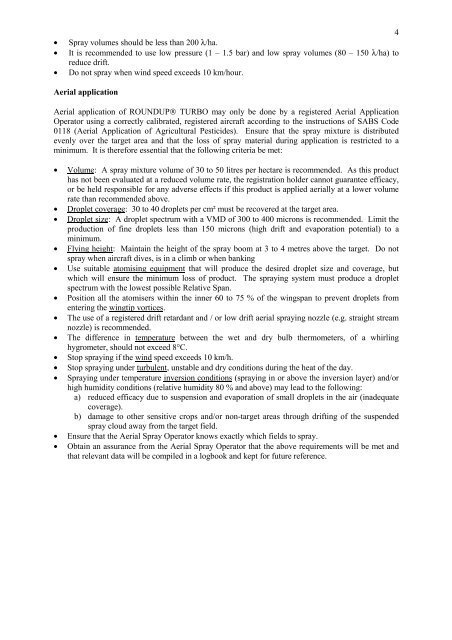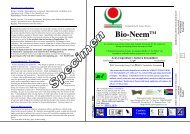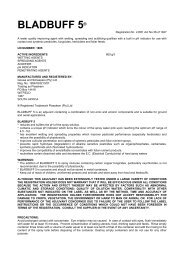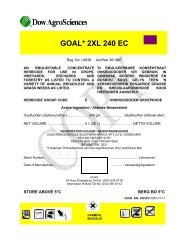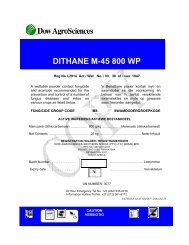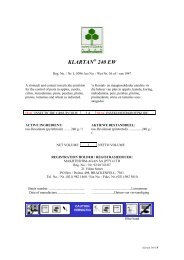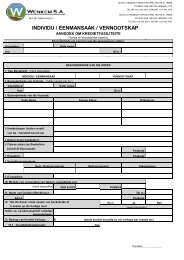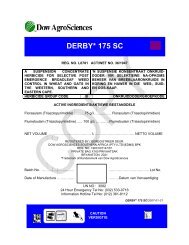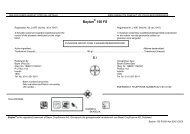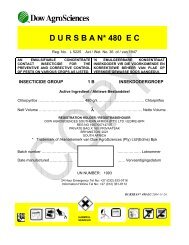ROUNDUP TURBO - Wenkem
ROUNDUP TURBO - Wenkem
ROUNDUP TURBO - Wenkem
Create successful ePaper yourself
Turn your PDF publications into a flip-book with our unique Google optimized e-Paper software.
4<br />
• Spray volumes should be less than 200 λ/ha.<br />
• It is recommended to use low pressure (1 – 1.5 bar) and low spray volumes (80 – 150 λ/ha) to<br />
reduce drift.<br />
• Do not spray when wind speed exceeds 10 km/hour.<br />
Aerial application<br />
Aerial application of ROUNDUP® <strong>TURBO</strong> may only be done by a registered Aerial Application<br />
Operator using a correctly calibrated, registered aircraft according to the instructions of SABS Code<br />
0118 (Aerial Application of Agricultural Pesticides). Ensure that the spray mixture is distributed<br />
evenly over the target area and that the loss of spray material during application is restricted to a<br />
minimum. It is therefore essential that the following criteria be met:<br />
• Volume: A spray mixture volume of 30 to 50 litres per hectare is recommended. As this product<br />
has not been evaluated at a reduced volume rate, the registration holder cannot guarantee efficacy,<br />
or be held responsible for any adverse effects if this product is applied aerially at a lower volume<br />
rate than recommended above.<br />
• Droplet coverage: 30 to 40 droplets per cm² must be recovered at the target area.<br />
• Droplet size: A droplet spectrum with a VMD of 300 to 400 microns is recommended. Limit the<br />
production of fine droplets less than 150 microns (high drift and evaporation potential) to a<br />
minimum.<br />
• Flying height: Maintain the height of the spray boom at 3 to 4 metres above the target. Do not<br />
spray when aircraft dives, is in a climb or when banking<br />
• Use suitable atomising equipment that will produce the desired droplet size and coverage, but<br />
which will ensure the minimum loss of product. The spraying system must produce a droplet<br />
spectrum with the lowest possible Relative Span.<br />
• Position all the atomisers within the inner 60 to 75 % of the wingspan to prevent droplets from<br />
entering the wingtip vortices.<br />
• The use of a registered drift retardant and / or low drift aerial spraying nozzle (e.g. straight stream<br />
nozzle) is recommended.<br />
• The difference in temperature between the wet and dry bulb thermometers, of a whirling<br />
hygrometer, should not exceed 8°C.<br />
• Stop spraying if the wind speed exceeds 10 km/h.<br />
• Stop spraying under turbulent, unstable and dry conditions during the heat of the day.<br />
• Spraying under temperature inversion conditions (spraying in or above the inversion layer) and/or<br />
high humidity conditions (relative humidity 80 % and above) may lead to the following:<br />
a) reduced efficacy due to suspension and evaporation of small droplets in the air (inadequate<br />
coverage).<br />
b) damage to other sensitive crops and/or non-target areas through drifting of the suspended<br />
spray cloud away from the target field.<br />
• Ensure that the Aerial Spray Operator knows exactly which fields to spray.<br />
• Obtain an assurance from the Aerial Spray Operator that the above requirements will be met and<br />
that relevant data will be compiled in a logbook and kept for future reference.


